Assam Scientist Shares How To Grow Super Mushrooms Worth Over Rs 2 Lakh/Kg
These rare Cordyceps mushrooms have medicinal properties backed by research. They are anti-inflammatory, anti-oxidant, anti-aging, anti-microbial, and anti-viral among other benefits.
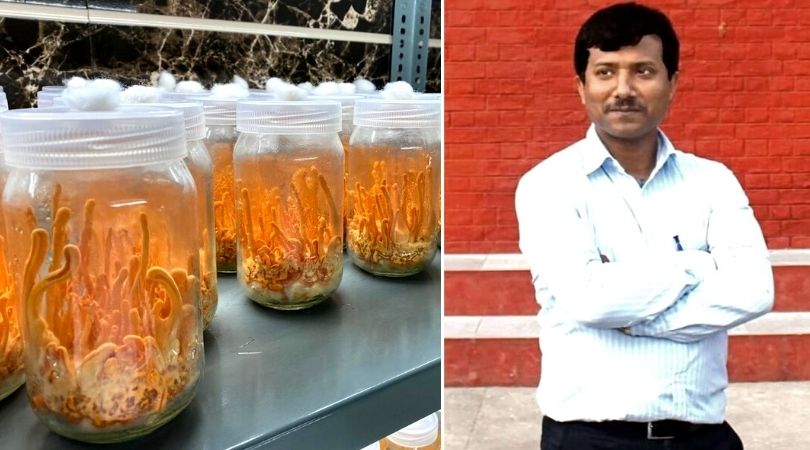
Nutty and nutritious, mushrooms have been a favourite of culinary experts from across the world for their unique umami taste. With over 14,000 known varieties in the world, they are not only a flavourful ingredient but packed with nutrients and medicinal properties, most of which are yet to be discovered.
It was this intrigue that drew Dr Sandeep Das to study mushrooms. The 40-year-old Professor and Dean of Faculty of Science & Technology at the Bodoland University in Assam has been actively researching different kinds of mushrooms for the past eight years.
“Historically, mushrooms have been a neglected species. There is so much scope for developing them and understanding how they can benefit us,” he says.
Super mushrooms with numerous benefits
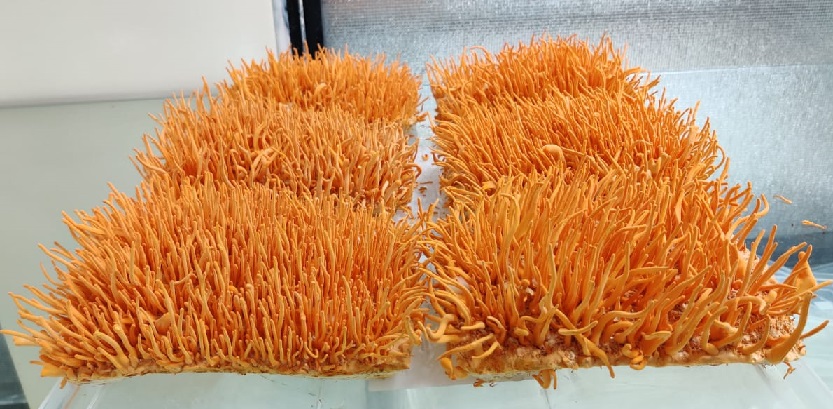
The researcher has developed methods to grow a particular type of mushrooms called Cordyceps, which are estimated to bring a minimum of Rs 2 lakh per kg! These rare mushrooms have anti-inflammatory, anti-oxidant, anti-aging, anti-cancer, anti-microbial, anti-bacterial, anti-viral, anti-diabetic, energy and immunity-boosting properties.
Entrepreneurs and farmers who grow these mushrooms in a controlled lab environment have been advised by Dr Sandeep. He has also skilled 2,652 farmers, students, and other interested folks across the north-east region in growing different sub-species of oyster mushrooms.
In Kokrajhar itself, they have closely worked with 48 farmers who have been groomed by them and have trained women from 25 self-help groups. They have begun producing spawn (for oyster mushrooms) in-house and are making it available to farmers at Rs 100 per kg, where one kg of spawn can grow 15 kg of mushrooms.
Because of their groundbreaking work in research and development of Cordyceps along with promoting entrepreneurship among farmers, they received over Rs 6 Crores in funding from state and central government agencies, notably the Department of Biotechnology (DBT).
With these grants, Dr Sandeep set up the ‘Technology Incubation Centre for Entrepreneurship on Mushroom Culture’ at Bodoland University. Here, he also set up a laboratory for their research.
The scientist tells us more about this unique super mushroom, how they began researching it and the best practices for growing these.
Discovering Cordyceps in the wild

When he joined the Bodoland University in September 2012, the curriculum demanded research on single-cell proteins, and mushrooms were the best example. At the time, he was focused on Animal Biotechnology.
“But there wasn’t any spawn (seed) available here to grow mushrooms. Commercially too, growing mushrooms had the potential to benefit farmers in this region,” explains the 40-year-old researcher.
He and a few other research scholars (working under his supervision) were sipping tea at a sweet shop, they spotted a pack of fresh mushrooms in the glass enclosure. “This immediately excited us, and we tracked down the farmer who was growing these oyster mushrooms. Finally, we got the spawn from him, and that is what got us started,” he says.
There on, he began researching types of mushrooms. As the north-east is densely forested with rich flora and fauna, the researcher with his students would venture out in the jungles with the hope of discovering some new variety.
“We would see dead spiders and insects with mushrooms sprouting from them. After looking at them closely, we found that it could be some kind of parasitic mushrooms like Cordyceps,” he says.
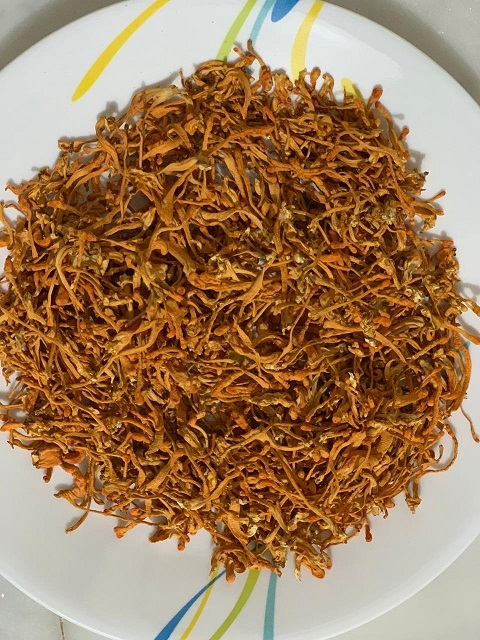
Cordyceps is a species of parasitic mushrooms with 400 identifiable subspecies. Its fungus attacks host insects like caterpillars and spiders.
“Most caterpillars or insects that are attacked by this fungus live under the ground. Once they have been infected, they make their way to the top and succumb to the disease. The mushroom then sprouts from them,” explains Dr Sandeep.
Mostly found in Nepal, China, Japan, Bhutan, and south-east Asian countries like Korea, Thailand, and Vietnam, these mushrooms thrive in humid climates and dense tropical forests. Their value is determined by the level of Cordycepin, a component that helps in the improvement of medical symptoms and conditions.
But, due to over-collection, the International Union for Conservation of Nature (IUCN) has listed this species in the Red List, as a threatened species.
Hence, conservationists suggest growing these mushrooms in a controlled environment to avoid extinction. However, instead of caterpillars, Dr Sandeep and his team are using rice as a medium to grow the super mushrooms (Cordyceps Militaris).
Culturing them in the lab
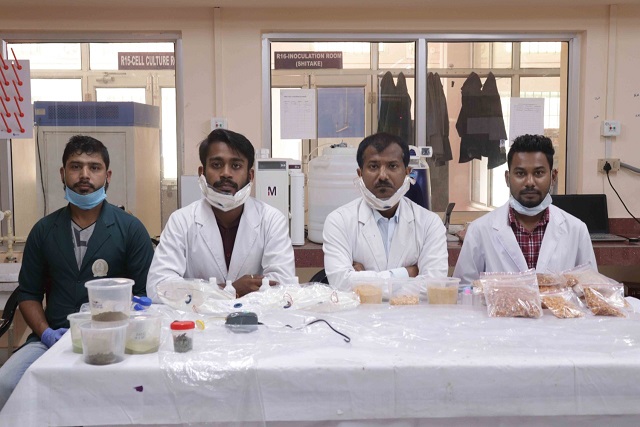
“We had two small rooms in the lab, where we decided to grow these mushrooms. For the growing medium, we used brown rice of good quality, and made mixtures of micro and macronutrients with a liquid media that contains strains of Cordyceps Mushrooms. This is all applied to the rice,” he says.
After that, the rice is kept in an autoclave for sterilisation, and needs to be kept in a dark area under controlled temperature for about 15 days. After this point, the rice becomes completely white. Then, for the next 45 days, the ‘light and dark’ period follows where mushrooms need to be kept under white fluorescent lights for 12 hours a day. While in the remaining 12 hours, it is to be kept in a dark place.
“You will notice that the rice slowly becomes pinkish and mushrooms start sprouting. In 60 days, the mushrooms are ready to be harvested,” he informs.
Once this is done, they are placed inside the lyophilizer, a machine that uses freeze-drying (cost temperatures) techniques. Dr Sanjay explains that farmers who are already growing this dehydrate the mushrooms in high temperatures. But, the moisture level isn’t completely stripped off.
“Although Lyophilizers have been existing for quite some time, not a lot of people have freeze-dried their mushrooms to -86 degrees. This completely strips off moisture levels and helps in increasing the longevity of the mushrooms without spoiling them, while also helping in easy consumption,” he says.

In addition to the main processes, Dr Sandeep also lists a few essential points for best practices. He says that having a clean set up is imperative. To achieve this, a HEPA filter was placed to clean the air (needed for growing the mushrooms), This can filter particles as small as 0.22 microns.
They also have an AC in place of the brand Lloyd ‘Hot and Chill’ AC. “The reason we opted this one is that you can keep the temperature at 16 to 17 degrees while maintaining the humidity levels at 85 or 90,” he says.
There is also an air curtain placed at the entry doors outside the room so that every time someone walks into the room, the load of the dirt is filtered.
Educating people and diversifying
Having been able to grow and dehydrate the Cordyceps mushrooms successfully, Dr Sandeep’s centre has been getting a lot of phone calls. These are mainly from interested students, farmers and entrepreneurs who want to either start growing the mushrooms or improve their knowledge.
Abu Road-based Raksha Baid contacted them after she read about their work. A nutritionist by training, Raksha decided to start her own business of selling dehydrated fruits and vegetables along with growing Cordyceps Militaris in her labs in Rajasthan.
“I was driven to provide a solution through healthy and natural ingredients. I am a vegetarian, and as a nutritionist, I am aware that a lot of vegetarians suffer from vitamin B12 deficiency, which plays a crucial role in the production of red blood cells. Cordyceps Militaris that I grow in my lab has this vitamin in good quantity,” she says.
Naturally, she wanted to get better at growing them.
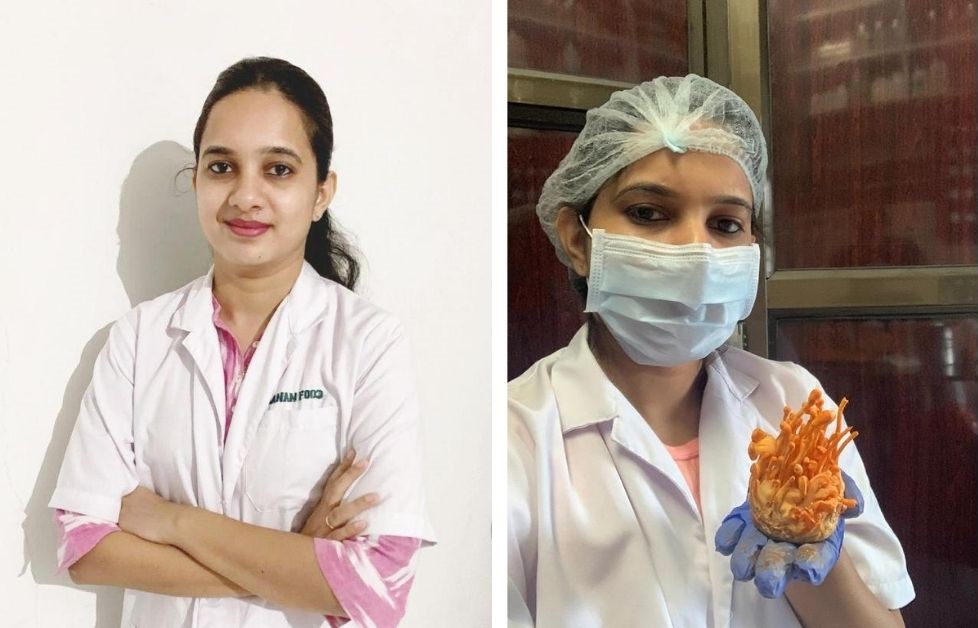
“Dr Sandeep advised me to grow these mushrooms in red, blue and yellow lights, in addition to the white light, and that seems to be working well. I also asked him about their freeze-drying technique. When situations normalise, I plan to visit them at their centre in Assam to learn more,” informs the 26-year-old.
Another Hyderabad-based entrepreneur, Atik Patel, has been running his venture, Clone Deals Pvt Ltd. for the past two years. They boast of the largest lab in India spread over 27,000 sq ft, growing primarily Cordyceps Militaris.
“I decided to call them to understand how they use the freeze technique. Although we do both, their freeze-drying technique is better because the colours, composition, feel, and nutritional properties of the mushrooms remain intact. They gave me some tips with regards to the light, temperature and other aspects,” says the 31-year-old.
But the real acknowledgement for the research by Dr Sandeep and his team comes from DBT itself.
Yogender Singh is the Manager at DBT-North Eastern Region Biotechnology Programmes. He recalls that this team approached the government body with a proposal to skill individuals in the region while also conducting further research.
“He has trained close to 3,000 people in growing commercial mushrooms while also discovering new ways of growing valuable ones like Cordyceps. He has done more than what was expected in a short time. One can only imagine what he can achieve in the future,” says the 38-year-old.
Challenges, learnings and looking ahead
Despite progress, the journey has not been devoid of challenges.

“When we started, it was pretty challenging. We were reading every bit of literature on mushrooms that we could get. There are a few people who have been working on developing Cordyceps, but the research still isn’t extensive in India,” shares Dr Sandeep.
This led them to learn through the old school trial-and-error method, which took time.
“Also, every element in the set-up was put together by us. This required a lot of fine-tuning in the process,” he says.
In the past few months, they have been providing their Cordyceps capsules to people in the area.
“We’ve made these 150 mg capsules (which are approved by FSSAI and ISO) which contain the powered Cordyceps. One can consume them as a capsule or empty the powder in a glass of hot water,” he says.
They have also been experimenting with food products with different varieties of oyster mushrooms grown in their lab. Dr Sandeep informs that the food technologist in their team has been using these mushrooms to make soup mixes, biscuits, cakes, papads and even rasgullas! These are sold in food exhibitions.
He hopes that farmers who grow mushrooms can be taught ways of processing their produce. This will encourage entrepreneurship too.
“Our focus as academicians is to not to simply focus on Cordyceps for their high value. We want to discover new mushrooms and research existing ones. For example, a particular mushroom may be poisonous on consumption, but it could act as a remedy for an ailment. There are so many possibilities and a lot more to discover,” he says.
To learn how to grow these mushrooms, contact: +91 91019 52358.
(Edited by Shruti Singhal)
If you found our stories insightful, informative, or even just enjoyable, we invite you to consider making a voluntary payment to support the work we do at The Better India. Your contribution helps us continue producing quality content that educates, inspires, and drives positive change.
Choose one of the payment options below for your contribution-
By paying for the stories you value, you directly contribute to sustaining our efforts focused on making a difference in the world. Together, let’s ensure that impactful stories continue to be told and shared, enriching lives and communities alike.
Thank you for your support. Here are some frequently asked questions you might find helpful to know why you are contributing?


This story made me
-
97
-
121
-
89
-
167













